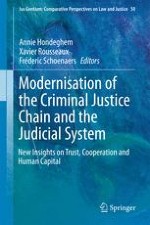2016 | OriginalPaper | Chapter
10. Visible and Invisible Sentencing
Author : Neil Hutton
Published in: Modernisation of the Criminal Justice Chain and the Judicial System
Publisher: Springer International Publishing
Activate our intelligent search to find suitable subject content or patents.
Select sections of text to find matching patents with Artificial Intelligence. powered by
Select sections of text to find additional relevant content using AI-assisted search. powered by
